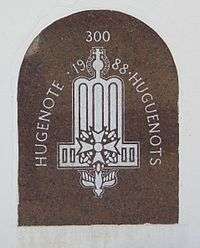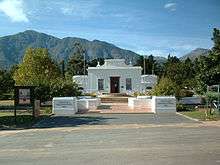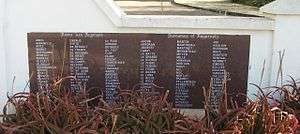Huguenots in South Africa

A large number of people of European heritage in South Africa are descended from Huguenots. Most of these originally settled in the Cape Colony, but were absorbed into the Afrikaner and Afrikaans population, because they had religious similarities to the Dutch colonists.
_-_Huguehnots_Building_their_Homesteads.jpg)
Even before the large-scale arrival of the Huguenots at the Cape of Good Hope in the 17th century, a small number of individual Huguenot refugees settled there. They included Francois Villion, later known as Viljoen, and the Du Toit brothers. In fact, the first Huguenot to arrive at the Cape of Good Hope was Maria de la Quellerie, the wife of governor Jan van Riebeeck, who started the settlement at the Cape of Good Hope in 1652 on behalf of the Dutch East India Company; however, she and her husband left for Batavia after ten years. After a commissioner was sent out from the Cape Colony in 1685 to attract more settlers, a more dedicated group of immigrants began to arrive. A larger number of French refugees began to arrive in the Cape after leaving their country as a result of the Edict of Fontainebleau which revoked the Edict of Nantes granting religious toleration of Protestants.
On 31 December 1687 a group of Huguenots set sail from France as the first of the large scale emigration of Huguenots to the Cape of Good Hope, which took place during 1688 and 1689. In total some 180 Huguenots from France, and 18 Walloons from the present-day Belgium, eventually settled at the Cape of Good Hope. A notable example of this is the emigration of Huguenots from La Motte d'Aigues in Provence, France. After this large scale emigration, individual Huguenot immigrant families arrived at the Cape of Good Hope as late as the first quarter of the 18th century, and the state-subsidised emigration of Huguenots was stopped in 1706.
This small body of immigrants had a marked influence on the character of the Dutch settlers. They were purposely spread out and given farms amongst the Dutch farmers. Owing to the policy instituted in 1701 of the Dutch East India Company which dictated that schools should teach exclusively in Dutch, that all official correspondence had to be done in Dutch, and strict laws of assembly, the Huguenots ceased by the middle of the 18th century to maintain a distinct identity, and the knowledge of French diminished and eventually disappeared as a home language.[1] This assimilation into the colonial population was also due to the fact that many Huguenot descendants married individuals from the Dutch population.
Franschhoek

Many of these settlers were allocated farms in an area later called Franschhoek, Dutch for "French corner", in the present-day Western Cape province of South Africa. The valley was originally known as Olifantshoek ("Elephant's Corner"), so named because of the vast herds of elephants that roamed the area. The name of the area soon changed to le Coin Français ("the French Corner"), and later to Franschhoek, with many of the settlers naming their new farms after the areas in France from which they came. La Motte, La Cotte, Cabriere, Provence, Chamonix, Dieu Donne and La Dauphine were among some of the first established farms-—most of which still retain their original farm houses today.
Museum and monuments


A large monument to commemorate the arrival of the Huguenots in South Africa was inaugurated on 17 April 1948 at Franschhoek. A museum dedicated to the Huguenot history in South Africa is located adjacent to the monument.
A smaller monument commemorating the 300th anniversary of the arrival of the Huguenots is located in the Johannesburg Botanical Garden.
Voortrekkers
French Huguenot descendants were also included in the exodus of frontier farmers that was called the Great Trek.[2]
Voortrekker surnames who were of French Huguenot ancestry include:[3]-
(Original french spelling in brackets)
- Aucamp (Auchamp)
- Boshof (Bossau)
- Bruwer (Bruere)
- Buys (Du Buis)
- Cilliers (Cellier)
- Cronje (Cronier)
- De Klerk (Le Clercq)
- Delport (Delporte)
- De Villiers
- Du Plessis
- Du Preez (Des Prez, Des Pres, Du Pre)
- Du Toit
- Duvenage (Duvinage)
- Fouche (Foucher)
- Fourie
- Hugo (Hugot, Hugod)
- Jacobs? (Jacob?)
- Jordaan (Jourdan)
- Joubert (Jaubert)
- Labuschagne (Labuscaigne)
- Le Roux
- Lombard (Lombaard)
- Malan (Mallan)
- Marais
- Maartens/Martins (Martin)
- Minnaar (Meinard, Mesnard)
- Meyer
- Naude
- Nel (Neel, Niel)
- Nortier / Nortje (Nourtier)
- Pienaar (Pinard)
- Retief (Retif)
- Reyneke? (Reyne?)
- Riekert? (Richarde?)
- Rossouw (Rousseau)
- Roux
- Senekal (Senecal, Senechal)
- Terblanche (Terreblanque)
- Theron (Therond)
- Tredoux
- Viljoen (Villion)
Legacy

There are many families, today mostly Afrikaans speaking, whose surnames bear witness to their Huguenot ancestry. A comprehensive list of these surnames can be seen on the Huguenot Memorial in the Johannesburg Botanical Garden. Examples of the more common names are Blignaut (Blignault), Cronje (Cronier), de Klerk (Le Clercq), Visagie (Visage), de Villiers, du Preez, du Plessis, du Toit, Fourie, Fouche, Giliomee (Guilliaume), Gous / Gouws (Gauch), Hugo, Joubert, Jordaan (Jourdan), Labuschagne (la Buscagne), Lange, le Roux, Leonard, Lombard, Malan, Michel, Malherbe, Marais, Nel, Nortje (Nourtier), Pienaar, Retief, Rossouw, Roux,[4] Terreblanche, Taljard, Theron and Viljoen (Villion).[5][6]
Some of the descendants of these original Huguenot families became prominent figures in South African society, most notably F.W. de Klerk, the last State President of apartheid-era South Africa.[7][8]
Some of the original forms of the surnames have been put in brackets.
- Aegidius Jean Blignaut, South African writer
- Jan F. E. Cilliers, Afrikaans-language poet, essayist, dramatist and reviewer.
- Sarel Cilliers, Voortrekker leader and a preacher.
- Hansie Cronje cricketer
- Piet Cronje leader of the Transvaal Republic's military forces during the First and Second Anglo-Boer Wars
- F.W. de Klerk (born 18 March 1936; "Le Clerc"), last State President of apartheid-era South Africa.
- Koos de la Rey, (Jacobus Herculaas de la Rey) (22 October 1847 – 15 September 1914) was a Boer general during the Second Boer War
- Fanie de Villiers, a former South African cricket player
- Abraham de Villiers, a South African cricket player (also known as AB de Villiers)
- Rilee Rossouw Top class all rounder cricketer
- Jean de Villiers, Springboks rugby player
- Pieter de Villiers, South African athlete and Olympian (400m hurdles)
- Morne du Plessis, Springboks rugby player
- I. D. du Plessis, poet
- Ampie du Preez, singer-songwriter
- Frik du Preez ("du Prez"), Springboks rugby player, named as South Africa's rugby player of the 20th century
- Max du Preez, journalist and author
- Alexander du Toit, geologist
- Daniel du Toit, South African astronomer
- Christiaan du Toit, South African military commander
- D. F. du Toit, co-founder of an Afrikaans language movement named the Society of Real Afrikaners
- S. G. du Toit, co-founder of an Afrikaans language movement named the Society of Real Afrikaners
- Stephanus Jacobus du Toit, co-founder of an Afrikaans language movement named the Society of Real Afrikaners
- Abraham Faure, (29 August 1795 – 28 March 1875) Cape clergyman and author
- Jacobus Johannes Fouché, (6 June 1898, Wepener – 23 September 1980[1] Cape Town) served as the second President of South Africa from 1968 to 1975
- Johnny Fourie, famous jazz guitarist.
- Elsa Joubert, South African novelist in Afrikaans
- Gideon Joubert, South African author and journalist Afrikaans science non-fiction author
- Marius Joubert, Springboks rugby player
- Petrus Jacobus Joubert, boer commandant-general of the South African Republic from 1880 to 1900
- Piet Joubert
- Ruda Landman[9]
- Frederick Le Roux, South African cricketer
- Garth Le Roux, South African cricketer
- Adolph Malan (1910–1963), known as Sailor Malan, Royal Air Force fighter pilot in the Second World War
- Daniel François Malan, who was a Prime Minister of South Africa elected on apartheid platform
- Magnus Malan, former South African Minister of Defence (in the cabinet of President P. W. Botha), Chief of the South African Defence Force (SADF) and Chief of the South African Army.
- Rian Malan, celebrated South African author, journalist and political activist.
- D. F. Malherbe, Afrikaans novelist
- Gideon Malherbe, co-founder of an Afrikaans language movement named the Society of Real Afrikaners
- Ben Marais
- Eugene Marais
- Sarie Marais
- Beyers Naudé, Afrikaner anti apartheid cleric.
- Charle-Pierre Naudé, poet
- Jozua Naudé, acting President of South Africa from 1967 to 1968
- Francois Pienaar, former Springboks rugby player; captain of the first Springboks team to win the Rugby World Cup in 1995
- Piet Retief, boer voortrekker
- Esta TerBlanche ("Terre-Blanche")
- Eugène Terre'Blanche ("Terre-Blanche"), South African political activist and leader of AWB
- Juan Theron, South African cricketer
- Charlize Theron, Hollywood actress
- Totius (Jakob Daniël du Toit) – poet
- Constand Viljoen ("Villion"), former leader of the South African Freedom Front (1994–2001) and SADF general
- Gerrit Viljoen
- H.D Viljoen (Former Inspector General SADF)
- Marais Viljoen
- Paul Visagie, athlete and direct descendant of General Piet Joubert
Various French-language first names have also gained popularity amongst Afrikaners, examples being Francois, Jacques, Pierre, Charles and Eugene.
Some Afrikaans writers have Huguenot surnames, and were involved in setting up the Society of Real Afrikaners.
The wine industry in South Africa was greatly influenced by the Huguenots,[10] many of whose families had owned vineyards in France. Many of the farms in the Western Cape province in South Africa still bear French names, such as Haute Cabrière, La Petite Provence, La Bourgogne, La Motte, La Bri, La Borie, La Chataigne and La Roche.
See also
- Huguenot Foundation of South Africa
- Huguenot
- Huguenot Monument
- Hugenot Memorial Building
- History of Cape Colony
- Protestantism in South Africa
- White South Africans
References
Notes
- ↑ History of the French Protestant Refugees, from the Revocation of the Edict of Nantes to our own days. M. Charles Weiss (Translated from the French by Henry William Herbert), 1854. New York: Stringer & Townsend.
- ↑ Bryer, Lynne and Theron, Francois. The Huguenot Heritage, The Story of the Huguenots at the Cape. Chameleon Press. Diep River. First Edition. 1987. Page 47.
- ↑ Visagie, Jan C. Voortrekkerstamouers 1835 - 1845. Protea Boekhuis. Pretoria. 2011.
- ↑ van der Bijl, Johannes. Die Familie Roux. ISBN 0-86965-464-0.
- ↑ Ces Francais Qui Ont Fait L'Afrique Du Sud. Translation: The French People Who Made South Africa. Bernard Lugan. January 1996. ISBN 2-84100-086-9
- ↑ "Genealogy". The Huguenot Memorial Museum. Retrieved 2009-04-20.
- ↑ Koinange, Jeff (21 December 2006). "De Klerk told Mandela: Timing of release not negotiable". CNN. Retrieved 2009-04-21.
- ↑ "The new South Africa: F W de Klerk's long trek". The Independent. 18 March 2006. Retrieved 2009-04-21.
- ↑ De Savoye, Jaques. "Carte Blanche on Ruda's Family Tree". Retrieved 2009-07-16.
- ↑ "Paths to Pluralism: South Africa's Early History". Michigan State University. Retrieved 2009-04-21.
Further reading
- Lugan, Bernard (1996). Ces Francais Qui Ont Fait L'Afrique Du Sud ("The French People Who Made South Africa"). Bartillat. ISBN 2-84100-086-9.
- Weiss, M. Charles (1854). History of the French Protestant Refugees, from the Revocation of the Edict of Nantes to our own days. (Translated from the French by Henry William Herbert) New York: Stringer & Townsend.
- Memory and Identity: The Huguenots in France and the Atlantic Diaspora, Bertrand Van Ruymbeke & Randy J. Sparks, Published 2003 Univ of South Carolina Press, ISBN 1-57003-484-2
- The Huguenots of South Africa 1688–1988, Pieter Coertzen & Charles Fensham, Published 1988 Tafelberg, ISBN 0-624-02623-X
- The French refugees at the Cape (1921), Botha, C. Graham, out of copyright on the Internet Archive
